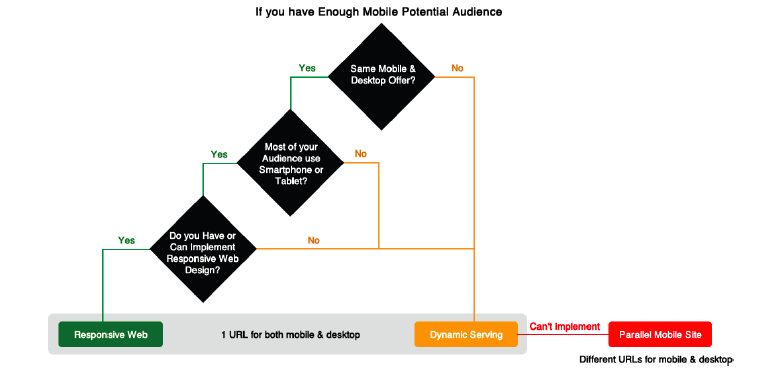We have many clients that come to us without a mobile website, which is a 100% necessity in today’s online world. Over 20% of all online traffic comes from mobile devices, so if your website is not mobile-friendly, you could turning away a good number of potential clients who search from their mobile devices. However, making your site mobile requires more than just the flip of a switch. There a are a few different mobile site architectures from which you must choose. Sometimes, this task can seem daunting, but today we’re going to break down the pros and cons of each option, and hopefully help make your decision a little easier.
Overall, there are basically three mobile site architectures from which you can choose:
 Click image to enlarge. Source:http://www.slideshare.net/aleydasolis
Click image to enlarge. Source:http://www.slideshare.net/aleydasolis
These days, most people have probably heard of the responsive design option, but it’s not the best solution for every website or every company. To decide among the different options, consider the below decision tree:
Click image to enlarge. Source:http://www.slideshare.net/aleydasolis
Going through this decision tree should give you a good idea of which mobile site architecture might be best for your company’s needs. Regardless, of which option you should decide to move forward with, it’s always a good idea to review all the choices before making a final decision. With that in mind, below is a breakdown of the pros and cons for each option.
Responsive Design
Pros
- 1 URL for both versions, no duplications
- Easier and cheaper to maintain
- Popularity consolidation
- No need for URL redirects
Cons
- Possible redesign needed
- Less differentiation of Mobile Content
- Lower mobile-focused user experience
Dynamic Serving
Pros
- 1 URL for both versions, no duplications
- Popularity consolidation
- Capacity to differentiate mobile content
- Better mobile user experience
Cons
- Complexity of technical implementation
- Higher cost of maintenance
Parallel Mobile Site
Pros
- Easier Implementation
- Capacity to differentiate mobile content
- Better mobile user experience
Cons
- Content duplication risk
- Split link popularity
- Higher cost of maintenance
While the technical implementation of each option poses no problem for us, you should consider that options, such as Dynamic Serving, which require more technical implementation will typically be more costly to implement, as a result.
If you need to make your site mobile, we encourage you to contact us. We can discuss all of the different options with you and help you make the best decision for your company.




